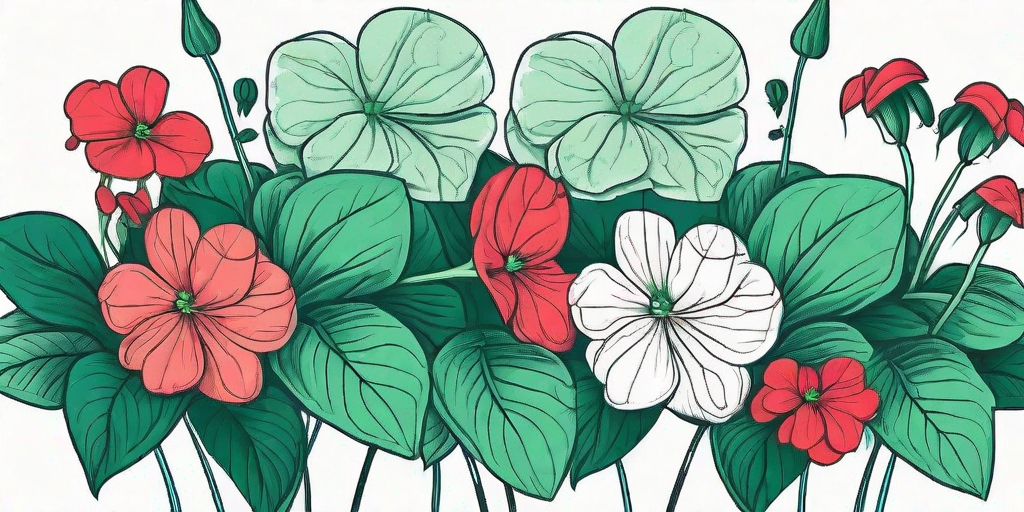
Impatiens, the vibrant, shade-loving flowers that grace many a garden, are known for their impatience. They're the divas of the plant world, demanding just the right amount of water, light, and attention. But when they're happy, they reward you with a riot of color that can brighten even the gloomiest corner of your garden. Unfortunately, like all divas, they're prone to a few health issues. But fear not, dear gardener, for we have the remedies to keep your impatiens in the pink (or red, or white, or whatever color they happen to be).
Understanding Impatiens Diseases
Before we dive into the nitty-gritty of impatiens diseases, let's take a moment to understand what we're dealing with. Impatiens diseases are usually caused by fungi, bacteria, or viruses. These microscopic troublemakers can cause a variety of symptoms, from wilting and yellowing leaves to stunted growth and, in the worst cases, death. But don't despair, dear gardener. With a little knowledge and a lot of love, you can keep your impatiens healthy and happy.
Now, let's get down to business. Here are some of the most common impatiens diseases and how to prevent and treat them.
Downy Mildew
Downy mildew is a fungal disease that can cause your impatiens to wilt, yellow, and eventually die. It's most common in cool, wet conditions, so if you live in a rainy climate or tend to overwater your plants, your impatiens may be at risk.
The best way to prevent downy mildew is to keep your impatiens in a well-ventilated area and avoid overwatering. If you notice signs of downy mildew, treat your plants with a fungicide as soon as possible.
Bacterial Leaf Spot
Bacterial leaf spot is another common disease that can cause your impatiens to look less than their best. This disease causes brown or black spots on the leaves of your plants, and in severe cases, can cause the leaves to fall off.
Preventing bacterial leaf spot is all about good hygiene. Avoid splashing water on the leaves of your plants, as this can spread the bacteria. If you notice signs of bacterial leaf spot, remove the affected leaves and treat your plants with a bactericide.
FAQs About Impatiens Diseases
Now that we've covered the basics, let's tackle some of the most frequently asked questions about impatiens diseases.
Can impatiens diseases spread to other plants?
Yes, many impatiens diseases can spread to other plants, especially if they're in close proximity. That's why it's so important to catch and treat these diseases early.
How often should I water my impatiens?
Impatiens like to be kept moist, but not soggy. A good rule of thumb is to water them when the top inch of soil is dry. But remember, overwatering can lead to diseases like downy mildew, so be careful not to drown your divas.
Preventing and Treating Impatiens Diseases: A Step-by-Step Guide
Now that we've covered the basics, let's get down to the nitty-gritty of preventing and treating impatiens diseases. Here's a step-by-step guide to keep your impatiens healthy and happy.
- Choose the right location: Impatiens prefer shade or partial shade, and well-drained soil. Avoid planting them in areas where water tends to pool.
- Water wisely: Water your impatiens when the top inch of soil is dry, and try to avoid getting water on the leaves.
- Keep them clean: Remove any fallen leaves or debris from around your impatiens to prevent the spread of diseases.
- Watch for signs of disease: If you notice wilting, yellowing leaves, or other signs of disease, act quickly to treat your plants.
- Treat as needed: Use a fungicide or bactericide to treat diseases as soon as you notice them.
With a little patience and a lot of love, you can keep your impatiens healthy and happy. So don't be impatient with your impatiens. They're worth the effort.
Conclusion
Impatiens may be a bit high maintenance, but they're worth it for the burst of color they bring to your garden. With a little knowledge and a lot of love, you can prevent and treat common impatiens diseases and keep your plants looking their best.
So say goodbye to impatient impatiens and hello to a garden full of healthy, vibrant flowers. Happy gardening!















